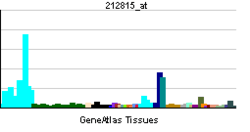ASCC3
| Activating signal cointegrator 1 complex subunit 3 | |||||||||||||
|---|---|---|---|---|---|---|---|---|---|---|---|---|---|
| Identifiers | |||||||||||||
| Symbols | ASCC3 ; ASC1p200; HELIC1; RNAH | ||||||||||||
| External IDs | OMIM: 614217 MGI: 1925237 HomoloGene: 4973 GeneCards: ASCC3 Gene | ||||||||||||
| EC number | 3.6.4.12 | ||||||||||||
| |||||||||||||
| RNA expression pattern | |||||||||||||
 | |||||||||||||
| More reference expression data | |||||||||||||
| Orthologs | |||||||||||||
| Species | Human | Mouse | |||||||||||
| Entrez | 10973 | 77987 | |||||||||||
| Ensembl | ENSG00000112249 | ENSMUSG00000038774 | |||||||||||
| UniProt | Q8N3C0 | E9PZJ8 | |||||||||||
| RefSeq (mRNA) | NM_001284271 | NM_198007 | |||||||||||
| RefSeq (protein) | NP_001271200 | NP_932124 | |||||||||||
| Location (UCSC) | Chr 6: 100.96 – 101.33 Mb | Chr 10: 50.59 – 50.85 Mb | |||||||||||
| PubMed search | |||||||||||||
Activating signal cointegrator 1 complex subunit 3 is a protein that in humans is encoded by the ASCC3 gene.[1][2]
Interactions
ASCC3 has been shown to interact with RELA,[3] C-jun[3] and Serum response factor.[3]
References
- ↑ Coulie PG, Ikeda H, Baurain JF, Chiari R (Jun 1999). "Antitumor immunity at work in a melanoma patient". Adv Cancer Res. Advances in Cancer Research 76: 213–42. doi:10.1016/S0065-230X(08)60778-2. ISBN 978-0-12-006676-6. PMID 10218103.
- ↑ "Entrez Gene: ASCC3 activating signal cointegrator 1 complex subunit 3".
- ↑ 3.0 3.1 3.2 Jung, Dong-Ju; Sung Hee-Sook, Goo Young-Wha, Lee Hyun Mi, Park Ok Ku, Jung Sung-Yun, Lim Janghoo, Kim Han-Jong, Lee Soo-Kyung, Kim Tae Sung, Lee Jae Woon, Lee Young Chul (Jul 2002). "Novel Transcription Coactivator Complex Containing Activating Signal Cointegrator 1". Mol. Cell. Biol. (United States) 22 (14): 5203–11. doi:10.1128/MCB.22.14.5203-5211.2002. ISSN 0270-7306. PMC 139772. PMID 12077347.
Further reading
- Hartley JL, Temple GF, Brasch MA (2001). "DNA Cloning Using In Vitro Site-Specific Recombination". Genome Res. 10 (11): 1788–95. doi:10.1101/gr.143000. PMC 310948. PMID 11076863.
- Wiemann S, Weil B, Wellenreuther R et al. (2001). "Toward a Catalog of Human Genes and Proteins: Sequencing and Analysis of 500 Novel Complete Protein Coding Human cDNAs". Genome Res. 11 (3): 422–35. doi:10.1101/gr.GR1547R. PMC 311072. PMID 11230166.
- Simpson JC, Wellenreuther R, Poustka A et al. (2001). "Systematic subcellular localization of novel proteins identified by large-scale cDNA sequencing". EMBO Rep. 1 (3): 287–92. doi:10.1093/embo-reports/kvd058. PMC 1083732. PMID 11256614.
- Jung DJ, Sung HS, Goo YW et al. (2002). "Novel Transcription Coactivator Complex Containing Activating Signal Cointegrator 1". Mol. Cell. Biol. 22 (14): 5203–11. doi:10.1128/MCB.22.14.5203-5211.2002. PMC 139772. PMID 12077347.
- Strausberg RL, Feingold EA, Grouse LH et al. (2003). "Generation and initial analysis of more than 15,000 full-length human and mouse cDNA sequences". Proc. Natl. Acad. Sci. U.S.A. 99 (26): 16899–903. doi:10.1073/pnas.242603899. PMC 139241. PMID 12477932.
- Ota T, Suzuki Y, Nishikawa T et al. (2004). "Complete sequencing and characterization of 21,243 full-length human cDNAs". Nat. Genet. 36 (1): 40–5. doi:10.1038/ng1285. PMID 14702039.
- Brandenberger R, Wei H, Zhang S et al. (2005). "Transcriptome characterization elucidates signaling networks that control human ES cell growth and differentiation". Nat. Biotechnol. 22 (6): 707–16. doi:10.1038/nbt971. PMID 15146197.
- Wiemann S, Arlt D, Huber W et al. (2004). "From ORFeome to Biology: A Functional Genomics Pipeline". Genome Res. 14 (10B): 2136–44. doi:10.1101/gr.2576704. PMC 528930. PMID 15489336.
- Mehrle A, Rosenfelder H, Schupp I et al. (2006). "The LIFEdb database in 2006". Nucleic Acids Res. 34 (Database issue): D415–8. doi:10.1093/nar/gkj139. PMC 1347501. PMID 16381901.